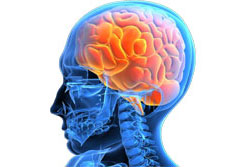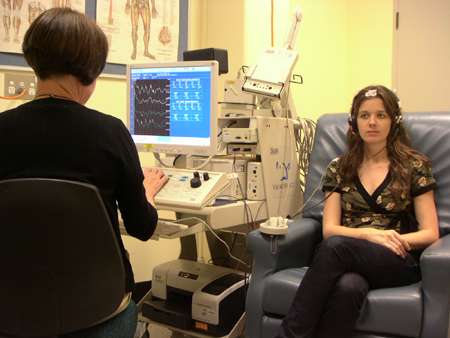Brainstem Auditory Evoked Potential (BAEP)
- What is a brainstem auditory evoked potential (BAEP)?
- When is the BAEP used?
- What does the BAEP detect?
- How to prepare for a BAEP test
- What happens during a BAEP test?
- Side effects of the BAEP test
- Factors influencing BAEPs
- What the results of the BAEP may show
- Clinical usefulness of the BAEP
- Summary of BAEPs
What is a brainstem auditory evoked potential (BAEP)?
 A brainstem auditory evoked potential (BAEP) is an evoked potential caused by an aural stimulus (a sound), usually a series of ‘clicks’. Electrodes positioned on the scalp record responses to the sounds; these are then observed as a reading on an electroencephalogram (EEG). Responses to aural stimuli originate from relay structures within the brainstem.
A brainstem auditory evoked potential (BAEP) is an evoked potential caused by an aural stimulus (a sound), usually a series of ‘clicks’. Electrodes positioned on the scalp record responses to the sounds; these are then observed as a reading on an electroencephalogram (EEG). Responses to aural stimuli originate from relay structures within the brainstem.
When is the BAEP used?
A doctor may recommend you go for a BAEP test if you have been experiencing changes in your hearing ability that may be due to problems with a particular nerve pathway. The changes in your hearing may not be complete hearing loss and may not be the same in both ears.
What does the BAEP detect?
From the BAEP a neurologist is able to determine the time it takes for an aural stimulus to travel from the point at the inner ear where the physical sound is translated into a bioelectrical impulse, to the brainstem. From these readings the neurologist can get an idea whether the auditory nerve is functioning properly. For example, an acoustic neuroma (a benign tumour of the ear canal) can stretch or compress the auditory nerve resulting in a long time for the processing of aural stimuli.
How to prepare for a BAEP test
- Wash your hair the night before
- Eat a normal meal and taking your normal medication on the day of the test should be fine.
- You should let the person conducting the test know if you use a hearing aid or have any obvious hearing problems.
What happens during a BAEP test?
The BAEP procedure itself is safe and non-invasive. For the procedure,
- Some electrodes will be glued to particular spots on your scalp or earlobe.
- You will be given special headphones or earplugs to wear.
- It is important that you listen carefully to what the person conducting the test says and follow their instructions. You will then listen to a series of ‘clicks’ through headphones.
- Responses to the clicks are recorded through the electrodes using special equipment.
- After the procedure the electrodes will be removed from your head.
- Your doctor will discuss the results of the test with you after they have been analysed; otherwise the referring doctor will.
 |
| (Image courtesy of Dr K Ng) |
Side effects of the BAEP test
The BAEP testing procedure is painless and side-effects are very rare. There is a chance you may have some minor skin irritation from the electrodes. After the procedure is finished, patients are usually able to return home on the same day. Given that you are well enough, you should be able to drive home after the procedure.
Factors influencing BAEPs
Age and gender have been found to have an effect on BAEP measurements; newborns tend to have longer latencies, which change with age. Females tend to have different response patterns to men. Brainstem responses are much more resistant to anaesthetic agents than visual evoked potentials (VEP) or somatosensory evoked potentials (SSEP), so these are usually not an issue.
What the results of the BAEP may show
BAEPs can be helpful in the diagnosis of:
- Hearing loss – Even if it is not complete, it can be detected as it this causes the BAEP to change.
- Acoustic neuroma – this is a benign tumour of the hearing canal that can stretch or compress the auditory nerve, causing possible complications.
- Multiple sclerosis – Patients with MS can have an abnormal BAEP even if signs or symptoms of brainstem impairment are not present.
- Sub arachnoid inflammation – this can be caused by subarachnoid haemorrhage, meningitis or Guillain-Barre syndrome.
- Other neurological disorders have been associated with an abnormal BAEP including Friedreich’s ataxia, hereditary cerebellar ataxia and B2 deficiency.
Clinical usefulness of the BAEP
 BAEP can be used to accurately assess conduction through the brainstem and auditory nerve pathways that are not as accessible to other testing procedures.
BAEP can be used to accurately assess conduction through the brainstem and auditory nerve pathways that are not as accessible to other testing procedures.- The BAEP can give information about patients with possible multiple sclerosis or other lesions affecting the auditory nervous system.
- BAEP monitoring is also used to monitor a patient’s status during neurosurgery surgery and sometimes in the intensive care unit (ICU).
- BAEP testing is often less costly than other techniques such as MRI.
Summary of BAEPs
Testing the brainstem auditory evoked potential (BAEP) involves monitoring responses to a series of ‘clicks’ using electrodes positioned on the scalp. It is useful in detecting problems associated with the auditory nerve system including acoustic neuroma or multiple sclerosis.
Article kindly reviewed by:
Associate Professor Karl Ng MB BS (Hons I) FRCP FRACP PhD CCT Clinical Neurophysiology (UK) Consultant Neurologist – Sydney North Neurology and Neurophysiology (download referral form and map); Conjoint Associate Professor – Sydney Medical School, University of Sydney; and Editorial Advisory Board Member of the Virtual Neuro Centre.
References
- Walsh P, Kane N, Butler S. The clinical role of evoked potentials. J Neurol Neurosurg Psychiatry. 2005;76 Suppl 2:ii16-22. [Full text]
- Biacabe B, Chevallier JM, Avan P, et al. Functional anatomy of auditory brainstem nuclei: Application to the anatomical basis of brainstem auditory evoked potentials. Auris Nasus Larynx. 2001;28(1):85-94. [Abstract]
- Nicholas JF, Samra SK. Sensory evoked potentials. Semin Anesth. 1997;16(1):14-27. [Abstract]
- Nuwer MR. Fundamentals of evoked potentials and common clinical applications today. Electroencephalogr Clin Neurophysiol. 1998;106(2):142-8. [Abstract]
- Deuschl G, Eisen A (eds). Recommendations for the Practice of Clinical Neurophysiology: Guidelines of the International Federation of Clinical Neurophysiology. Electroencephalogr Clin Neurophysiol Suppl. 1999;52:1-304. [Abstract]
Dates
Tags
Created by:

 Login
Login














